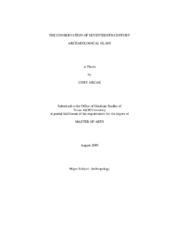| dc.description.abstract | The primary goal of the conservator is to stabilize and conserve artifacts with the best possible treatment available. Ideally, these treatments are noninvasive and reversible, and maintain the integrity of the object as a top priority. In this respect, it is the responsibility of the conservator to research other possible treatments when traditional methods prove to be insufficient to properly stabilize and conserve an object. Sometimes choosing to treat with a seemingly unorthodox method is the only chance for the objects survival. Though glass is considered one of the most stable archaeological materials, noninvasive, reversible treatments are not always possible given the level of deterioration glass objects undergo within the archaeological setting, specifically the underwater or waterlogged archaeological setting.
This research is a consideration and investigation of the use of silicone polymers and silanes as consolidation materials for 17th-century glass recovered from aqueous environments. Working within the Conservation Research Laboratory and the Archaeological Preservation Research Laboratory at Texas A and M University, a newly developed polymer passivation technique utilizing materials acquired from the Dow Corning Corporation was applied to archaeological glass recovered from the 1686 shipwreck La Belle, excavated in Matagorda Bay off the coast of Texas by the Texas Historical Commission from 1996 to 1997.
The successful application of a hydroxyl ended silicone polymer Q-1 3563, combined with a methyltrimethoxysilane intermediate crosslinker, Q-9 1315, at a 15% solution by weight and catalyzed with dibutyltin diacetate (DBTDA Fascat 4200) occurred in 1999. This project was the first large scale application of silicone polymers and silanes to 17th-century archaeological glass recovered from a marine site. Through this investigation we answered a number of questions regarding the use and application of the silicone technologies and confirmed that these materials are a viable resource for glass consolidation and conservation in terms of the suggested conservation guidelines of the IIC. The silicone technology was successfully applied to numerous types, forms, colors and degradation levels of glass. This included successful application to composite artifacts and the retreatment of objects unsuccessfully treated with a "traditional" method. | en |


